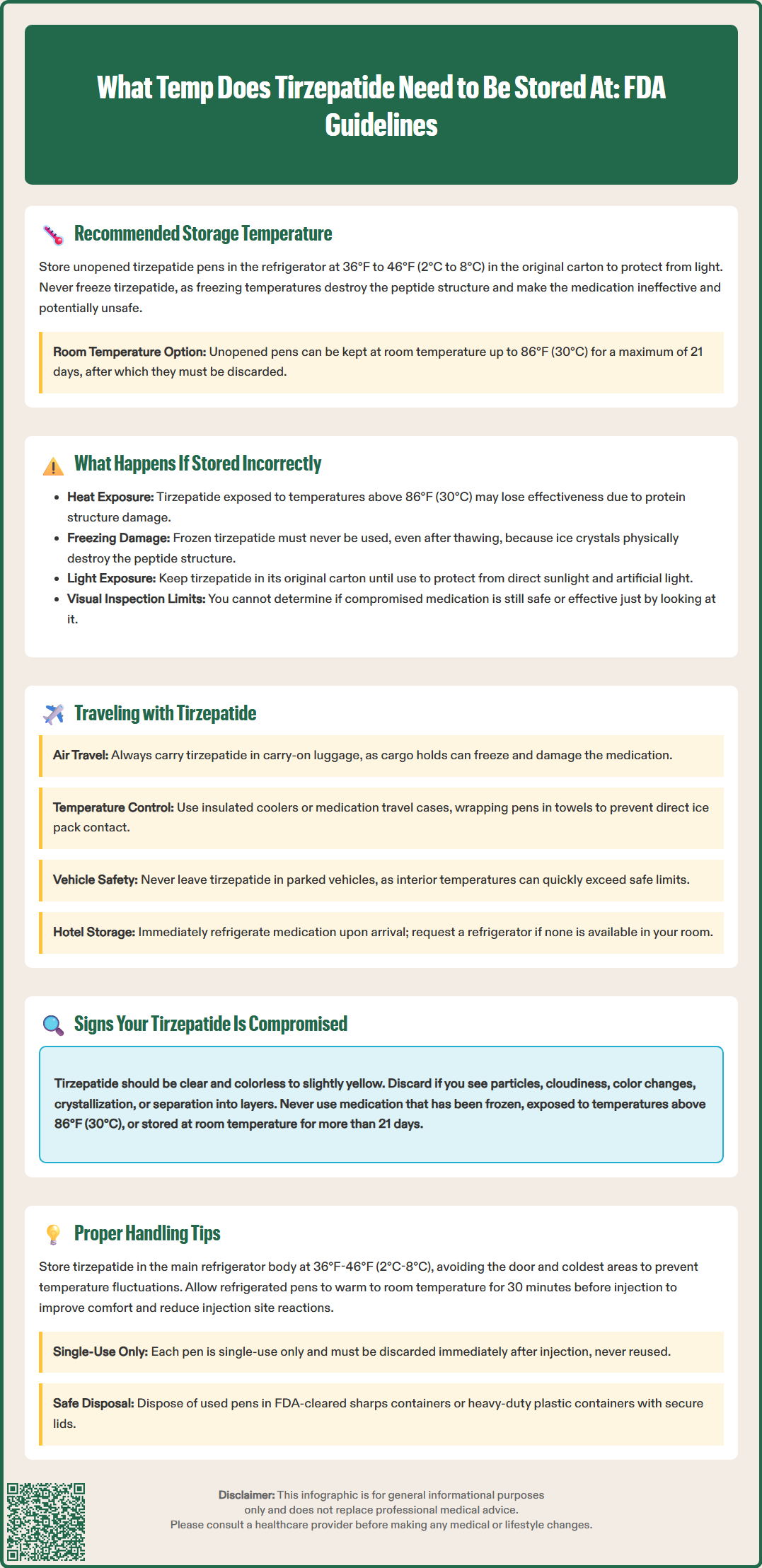LOSE WEIGHT WITH MEDICAL SUPPORT — BUILT FOR MEN
- Your personalised programme is built around medical care, not willpower.
- No generic diets. No guesswork.
- Just science-backed results and expert support.
Find out if you’re eligible

Tirzepatide (Mounjaro, Zepbound) is a dual GIP and GLP-1 receptor agonist approved by the FDA for type 2 diabetes and chronic weight management. As a biologic peptide medication, tirzepatide requires precise temperature control to maintain its molecular structure and therapeutic effectiveness. Unopened pens must be refrigerated at 36°F to 46°F (2°C to 8°C) and protected from light and freezing. Understanding proper storage requirements is essential for patients and healthcare providers to ensure medication safety, preserve therapeutic efficacy, and prevent treatment failure. This guide provides comprehensive information on tirzepatide storage, handling, travel considerations, and identifying compromised medication.
Quick Answer: Unopened tirzepatide pens must be stored refrigerated at 36°F to 46°F (2°C to 8°C) and may be kept at room temperature up to 86°F (30°C) for up to 21 days.
Tirzepatide (Mounjaro, Zepbound) is a glucose-dependent insulinotropic polypeptide (GIP) and glucagon-like peptide-1 (GLP-1) receptor agonist approved for type 2 diabetes and chronic weight management. As a biologic peptide medication, tirzepatide requires specific temperature control to maintain its structural integrity and therapeutic efficacy.
According to FDA-approved labeling, unopened tirzepatide pens must be stored in a refrigerator at 36°F to 46°F (2°C to 8°C). The medication should be kept in its original carton to protect it from light until the time of use. Tirzepatide should never be frozen; exposure to freezing temperatures can denature the peptide structure, rendering the medication ineffective and potentially unsafe.
If removed from refrigeration, a tirzepatide pen may be kept at room temperature (up to 86°F or 30°C) for up to 21 days before use. After this period, the pen should be discarded even if unused. It's important to note that Mounjaro and Zepbound pens are single-dose devices that should be discarded immediately after injection.
Healthcare providers should counsel patients on proper storage at the time of prescribing. Pharmacists play a critical role in ensuring cold-chain integrity during dispensing and providing written storage instructions. Patients should verify that their medication has been properly refrigerated at the pharmacy and transport it home promptly in an insulated container if ambient temperatures exceed recommended ranges. Proper storage is not merely a convenience issue—it is essential for medication safety and therapeutic effectiveness.

Improper storage of tirzepatide can compromise the medication's molecular structure, leading to reduced efficacy or complete loss of therapeutic activity. Peptide-based biologics like tirzepatide are particularly vulnerable to temperature extremes, which can cause protein denaturation, aggregation, or degradation of the active pharmaceutical ingredient.
Exposure to temperatures above 86°F (30°C) may accelerate chemical degradation. High temperatures can potentially alter the three-dimensional protein structure and affect the stability of tirzepatide molecules. If a pen has been exposed to temperatures above 86°F (30°C), patients should contact their pharmacist or the manufacturer for specific guidance rather than using the medication. Patients using compromised tirzepatide may experience suboptimal glycemic control or inadequate weight loss.
Freezing poses an even greater risk to tirzepatide integrity. Ice crystal formation during freezing can physically disrupt the peptide structure. According to FDA labeling, frozen tirzepatide should never be used, even if it appears normal after thawing. Visual inspection alone cannot detect molecular-level damage from freezing.
Exposure to direct sunlight or intense artificial light can also potentially degrade tirzepatide. This is why the medication must remain in its original carton until use. From a patient safety perspective, using improperly stored tirzepatide carries risks beyond treatment failure. When storage conditions are uncertain, the safest approach is to contact the pharmacist or manufacturer for guidance. Patients should never attempt to salvage medication that has been stored outside recommended parameters.
Traveling with tirzepatide requires advance planning to maintain appropriate storage conditions throughout the journey. Whether traveling domestically or internationally, patients must ensure continuous temperature control to preserve medication integrity and avoid treatment interruptions.
For air travel, tirzepatide should be carried in carry-on luggage rather than checked baggage. Cargo holds in aircraft can experience freezing temperatures that will damage the medication. Patients should pack tirzepatide in an insulated medication travel case with frozen gel ice packs, but keep the pen insulated from direct contact with ice packs to prevent freezing. Avoid using dry ice, as this creates extremely cold temperatures that may freeze the medication. The Transportation Security Administration (TSA) permits medications and associated cooling supplies in carry-on bags; patients should inform security personnel that they are carrying refrigerated medication. A letter from the prescribing physician documenting the medical necessity can facilitate security screening, though it is not legally required.
For road trips or extended outings, patients should use insulated coolers or specialized medication travel cases designed to maintain 36°F to 46°F (2°C to 8°C). Avoid placing tirzepatide directly against ice packs, as direct contact may cause localized freezing. Instead, wrap the medication in a small towel or use a barrier within the cooler. Never leave tirzepatide in a parked vehicle, where interior temperatures can rapidly exceed safe limits—even on mild days, car interiors can reach 100°F or higher within minutes.
When staying at hotels or other accommodations, immediately refrigerate tirzepatide upon arrival. If a refrigerator is not available in the room, request one from hotel staff or ask to store medication in a facility refrigerator (such as at the front desk or restaurant kitchen). For extended international travel, research local pharmacy regulations in case replacement medication is needed. Patients should carry documentation of their prescription and consider bringing extra supplies when feasible. Time zone changes do not affect storage requirements, but patients should maintain their dosing schedule according to their healthcare provider's instructions.
Identifying compromised tirzepatide requires careful visual inspection and awareness of storage history, though molecular degradation may not always produce visible changes. Patients should examine their medication before each injection and understand the warning signs that indicate potential compromise.
Normal tirzepatide solution should be clear and colorless to slightly yellow. Before use, hold the pen up to the light and inspect the solution through the viewing window. The liquid should be free of visible particles, cloudiness, or discoloration. Any deviation from this appearance suggests potential degradation or contamination. Specifically, patients should not use tirzepatide if they observe:
Particulate matter or floating particles in the solution
Cloudiness or turbidity rather than crystal-clear appearance
Color changes, including darkening or unusual tints
Crystallization or solid material in the cartridge
Separation of the solution into layers
If the pen has been frozen, even if subsequently thawed, the medication should be discarded regardless of appearance. Freezing causes irreversible damage that visual inspection cannot detect. Similarly, if a pen has been exposed to temperatures above 86°F (30°C), patients should contact their pharmacist or the manufacturer for guidance.
Mechanical issues with the pen device may also indicate problems. If the pen mechanism is damaged, if the cap is cracked or missing, or if there are signs of leakage, the medication should not be used. Compromised packaging integrity can allow bacterial contamination even if the solution appears normal.
Patients should note the date when a pen is removed from refrigeration and calculate the discard-by date (21 days later) for unused pens kept at room temperature. Do not use beyond the labeled expiration date. Remember that Mounjaro and Zepbound pens are single-dose devices that should be discarded immediately after injection. When in doubt about medication integrity, patients should contact their pharmacist or healthcare provider rather than risk using compromised medication.
Implementing systematic storage and handling practices helps ensure tirzepatide maintains its therapeutic efficacy throughout the treatment course. Healthcare providers should provide comprehensive patient education on proper medication management at the time of prescribing.
Refrigerator storage best practices include placing tirzepatide in the main body of the refrigerator rather than the door, where temperature fluctuations are more common. Avoid storing medication in the coldest areas (typically the back wall or bottom shelf) where inadvertent freezing may occur. Keep tirzepatide in its original carton to protect from light and to help identify the medication easily. Use a refrigerator thermometer to verify that the temperature remains consistently between 36°F and 46°F (2°C to 8°C). If power outages occur, keep the refrigerator door closed; most refrigerators will maintain safe temperatures for several hours if unopened.
Room temperature storage, when utilized for unopened pens, requires attention to ambient conditions. Store the pen away from direct sunlight, heat sources (such as radiators or heating vents), and humid environments like bathrooms. A bedroom drawer or closet shelf typically provides appropriate conditions. Mark the date when the pen was removed from refrigeration and set a reminder to discard it after 21 days if unused.
Handling precautions include allowing refrigerated pens to reach room temperature before injection (approximately 30 minutes) to improve injection comfort and reduce injection site reactions. Always inspect the solution before use. Do not shake the pen vigorously, as this can potentially damage the medication. Use proper injection technique as demonstrated by healthcare providers, rotating injection sites to minimize local reactions.
Important reminder: Each Mounjaro or Zepbound pen is a single-dose device that should be discarded immediately after injection.
Disposal of used pens should follow FDA guidelines for sharps disposal. Place used pens in an FDA-cleared sharps container or a heavy-duty plastic container with a secure lid. Never dispose of pens in household trash or recycling bins. Many communities offer sharps disposal programs or mail-back options. Patients should consult local regulations or ask their pharmacist about disposal resources in their area. Proper disposal protects household members, waste handlers, and the environment from potential needle-stick injuries and medication exposure.
If the pen was left at room temperature (up to 86°F or 30°C) for less than 21 days total and was not frozen or exposed to extreme heat, it may still be used. Mark the date it was removed from refrigeration and discard after 21 days at room temperature.
Never use tirzepatide that has been frozen, even if it appears normal after thawing. Freezing causes irreversible molecular damage to the peptide structure that cannot be detected by visual inspection alone.
Carry tirzepatide in your carry-on luggage in an insulated medication case with gel ice packs, ensuring the pen does not directly contact ice to prevent freezing. Never place tirzepatide in checked baggage where cargo hold temperatures can freeze the medication.
All medical content on this blog is created using reputable, evidence-based sources and is regularly reviewed for accuracy and relevance. While we strive to keep our content current with the latest research and clinical guidelines, it is intended for general informational purposes only.
This content is not a substitute for professional medical advice, diagnosis, or treatment. Always consult a licensed healthcare provider with any medical questions or concerns. Use of this information is at your own risk, and we are not liable for any outcomes resulting from its use.